What is SDET?
A software development engineer in test (SDET) is an IT professional primarily responsible for the creation of automated test frameworks, design and implementation of test cases, and writing code to improve the overall testability of software. The SDET role was formed at the intersection of testing and development skills. Being, so to say, a Jack of both trades, this is a senior-level position originally coined by Microsoft and then successfully used by many large enterprises.Typically, the SDET focuses on designing and implementing automated testing processes and tools for software products. Unlike a developer who actually writes the product code, a software development engineer in test focuses on creating test code to ensure the product is functioning properly. This specialist also creates tools to help writing, running, and maintaining both product and test codes.
For example, a software development engineer in test is responsible for building automation frameworks for tests and other test-related development processes, such as continuous delivery pipelines. This also may include (but is not limited to) writing and executing automated test scripts, analysis of test results, and so on. On a daily basis, an SDET works closely with software developers and quality assurance (QA) teams to timely identify and resolve software defects.
By the way, if you want a better insight on what a software testing process is and how quality assurance works, we have a separate video dedicated to this topic. Hope you’ll enjoy watching it.
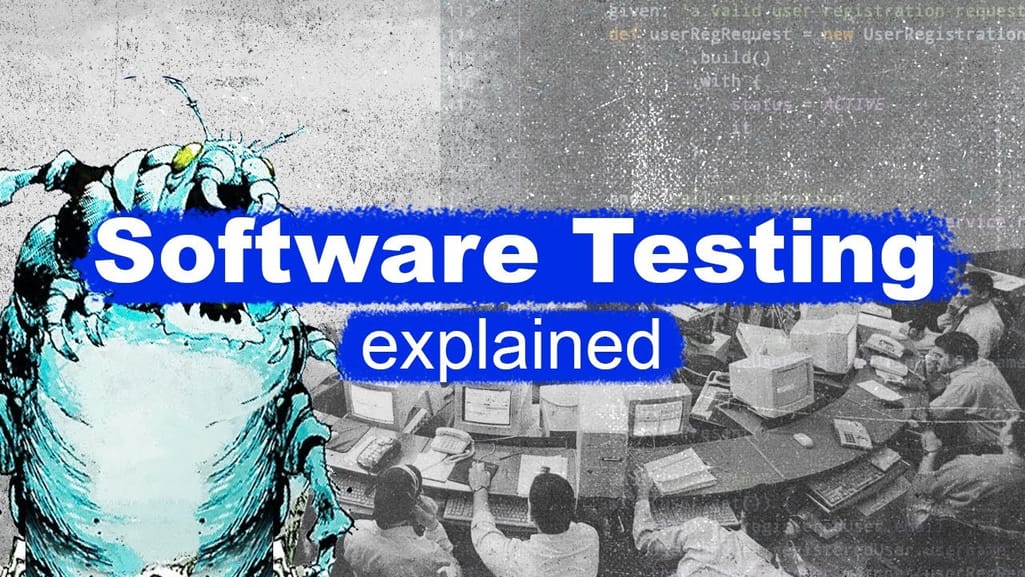

Get to know more about software testing
As the SDET role combines both software development and testing expertise, it’s quite often confused with the role of a software test engineer or a QA engineer. While the differences are blurred and not always pronounced, let’s try to articulate some of them and briefly discuss the roles of a QA engineer and an SDET.
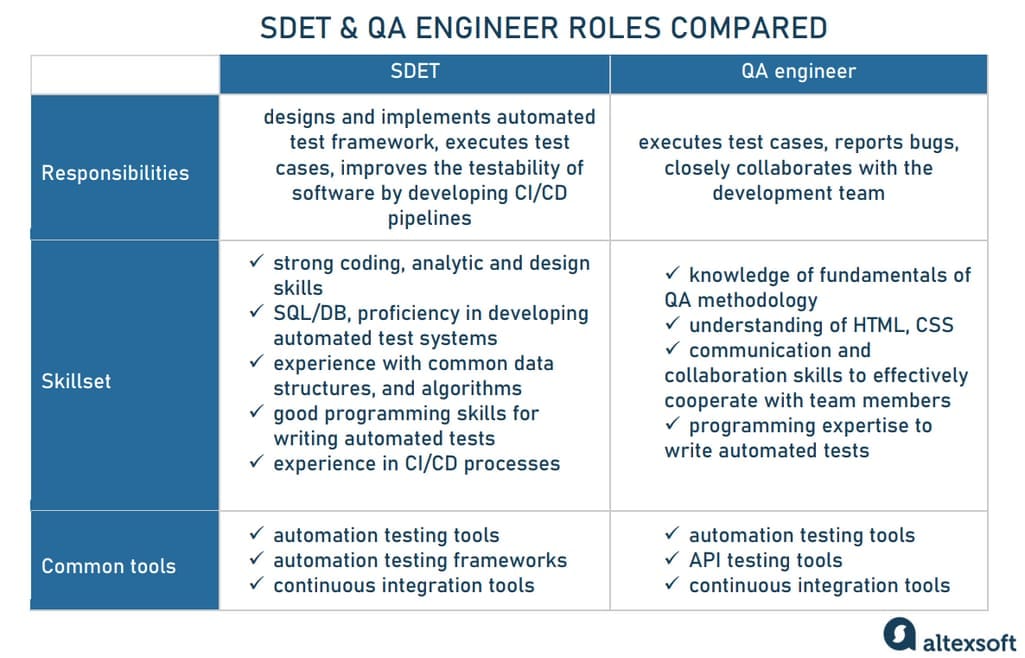
SDET and QA engineer roles comparison chart
SDET vs QA engineer
A quality assurance (QA) engineer is a tech specialist responsible for the development and execution of test cases, both manually and automatically, to ensure software quality. This role is more focused on actual testing tasks, such as test planning, test execution, test automation, and so on. A QA engineer has to identify and document defects, work with developers to resolve issues, and effectively collaborate with stakeholders to ensure the software meets all user requirements. This specialist also participates in release and deployment activities to ensure software is ready for production.
One of the main differences between the two is that while a QA engineer is primarily responsible for creating automated tests, the software development engineer in test’s role involves more development-focused tasks, like building automation frameworks, writing code to support testing, etc.
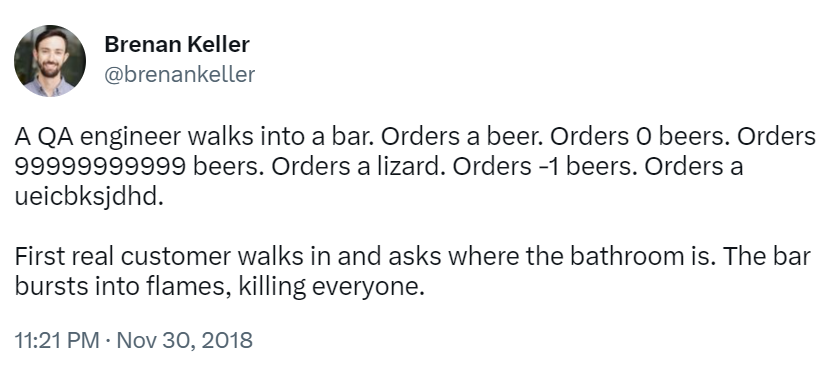
QA engineering requires a bit of meticulousness… you know, at times. Source: Twitter
The roles of an SDET and a QA engineer are also different concerning the essential skills required. For instance, the SDET specialist needs a strong development background and experience with multiple programming languages, test automation tools and frameworks. For a QA engineer, the focus here will be more on a strong understanding of testing practices and less of technical programming expertise.
In fact, a QA engineer can become an SDET, but this will require a solid enhancement of coding and debugging skills, as a software development engineer in test role presupposes a broad scope of software development responsibilities. Taking the appropriate training and obtaining an SDET certification is also highly recommended in this case.
SDET responsibilities
Below, we mention some of the essential tasks and duties of a software development engineer in test. However, this list can be extended by many other options typically included in the set or responsibilities for a software engineer and a QA automation engineer.
Creating and developing automated testing frameworks
In testing, as a part of a software development life cycle (SDLC), an automation framework is a set of process steps, tools, and guidelines used to create a shared process of automation, and build further test cases. The SDET’s role here is to set up, maintain, and perform them on multiple application platforms like mobile, desktop, and web to build acceptance tests and test scenarios. This involves writing code that can simulate user actions and interactions with the software, as well as verifying the results of those actions.
For instance, a company that develops a mobile banking application can develop an automated testing framework that will simulate user interactions with the app, like logging in, transferring funds, checking bank accounts, etc. Such a framework will automatically run these tests each time a new version of the app is released to make sure the software product is working correctly.
Designing and implementing test cases
This is one of the core responsibilities of an SDET that involves creating a set of test scenarios and test cases used to verify that the software application (or other type of product) is properly functioning. This may concern multiple purposes, like creating test cases for new features, for regression or performance testing.
Let’s take an example with creating new features: We have an SDET who works on the development of a new social media platform and can design test cases for a new feature that’ll allow users to upload and share videos. The software development engineer in test role here would be to create test cases that verify whether the video is uploading correctly, whether it can be played back on different devices, etc.
Developing CI/CD pipelines
Continuous integration and continuous delivery/deployment (CI/CD) is a software development practice that involves integrating code changes in the software codebase and deploying them to production. The main goal of CI/CD is to make the software development process more efficient, reliable, and scalable. The SDET’s role in the development of CI/CD pipelines is to create execution pipelines and optimize testing strategies to provide a good test coverage. If you don’t have a DevOps engineer on board, an SDET can take charge of designing CI/CD workflow.

Getting prepared for the SDET role can turn out to be philosophical. Source: Quick Meme
Now, let’s talk about the hard and soft skills required for a software development engineer in test.
SDET skillset
As we’ve previously mentioned, an SDET is a senior-level specialist with an advanced set of skills in both development and testing processes. Below, we’ve gathered some main ones, but this list is not exhaustive, and there are additional skills required for this role.
Hands-on experience with multiple test automation tools and frameworks. A software development engineer in test is the one that has to use test automation tools and frameworks for improving test case creation, simplifying the debugging process. A lot depends on the ability of an SDET to integrate these frameworks and tools in the software development workflow, as it will help the engineer focus on other crucial tasks and duties like UX testing, end-user usability testing, etc.
Knowledge of multiple software testing methodologies and tools. The SDET has to be proficient in testing methodologies such as unit, integration, system, performance tests, and others. As for the testing tools, the examples are Selenium Web Driver, Katalon, Watir, and others. However, the exact tech stack depends on a particular product. An SDET also takes the lead role in choosing tools that are to be used.
Great command in at least one programming language. As the SDET role presupposes a lot of testing, a solid expertise in at least one common programming language is necessary. This usually includes the knowledge of Java, JavaScript, Python, or C#.
As for the soft skills for the SDET role, this usually includes the following:
Organizational and time-management skills. Professionals like an SDET can often work on several projects at once. This requires them to work with more than a single test automation tool deployed across several environments. Here, exceptional organizational and time-management skills can help an SDET complete all the projects according to the deadlines by setting clear goals, creating strict schedules, and prioritizing tasks that need to be done.
Communication skills. Day-to-day responsibilities of an SDET are not limited to development and testing-related tasks. Being a senior-level specialist, one also has to participate in frequent stakeholder meetings, and closely collaborate with the development team, etc. Therefore, communication skills are not less crucial than technical expertise.
SDET career path
To become a software development engineer in test, one should obtain a bachelor’s or master’s degree in computer science, computer engineering, or related fields. Still, having the relevant educational background isn’t the single requirement here. Specialists that want to apply for this senior-level position must have not less than five years of experience in software development, QA engineering, test automation, or other software development and testing-related specialty.
Below, we’ve prepared a table that represents the skillset, the educational and work background of SDET professionals that are now working for leading data-driven enterprises.
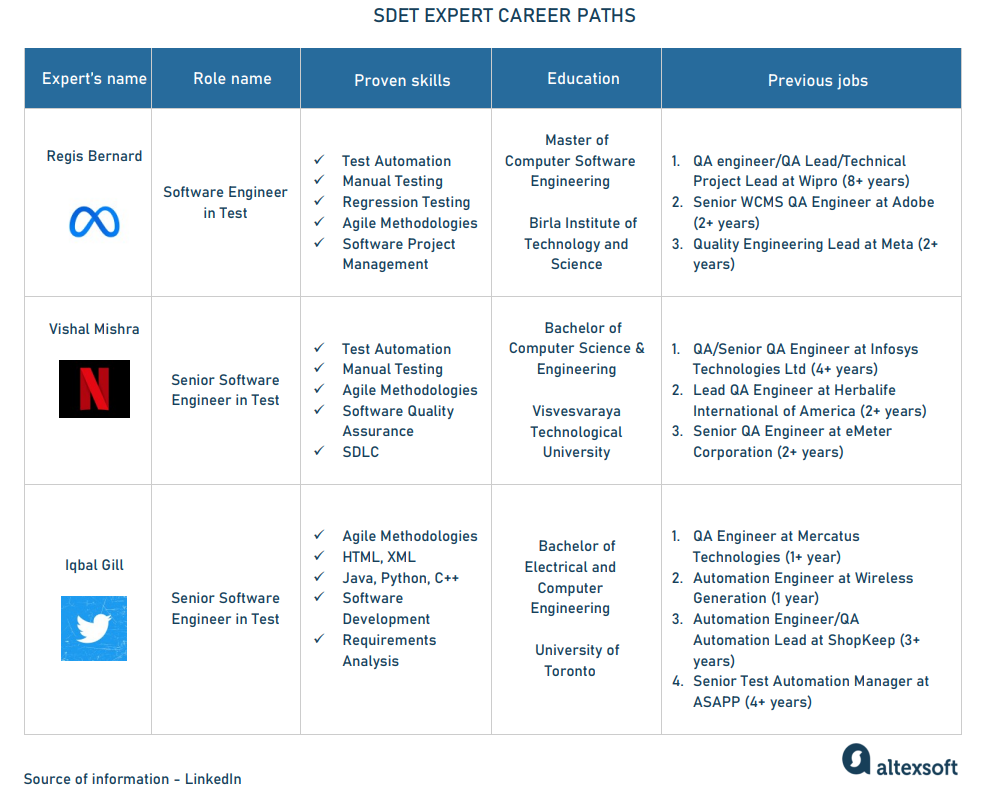
Background and skills of SDET. Examples from LinkedIn
As an SDET is a senior-level position, obtaining additional certification will definitely be welcomed. Getting certified will help both testers-to-be and those already practicing to equip themselves with the right skillset, refresh their basic knowledge in testing and development processes, and apply for a high-level position in large and prestigious companies.
SDET certifications and courses
We have selected some relevant certifications designed for QA specialists that may also contribute to the skillsets of SDET professionals.
A4Q Software Development Engineer in Test (SDET)
Exam duration: 60 minutes
Exam questions: 40
Exam price: $235
Software Development Engineer in Test Foundation Level Certification is the certification for SDET specialists developed by A4Q in cooperation with the German Testing Board. Getting this certification can help SDETs increase their competence and confidence in terms of using relevant testing methods, approaches, and techniques throughout the entire software development lifecycle.
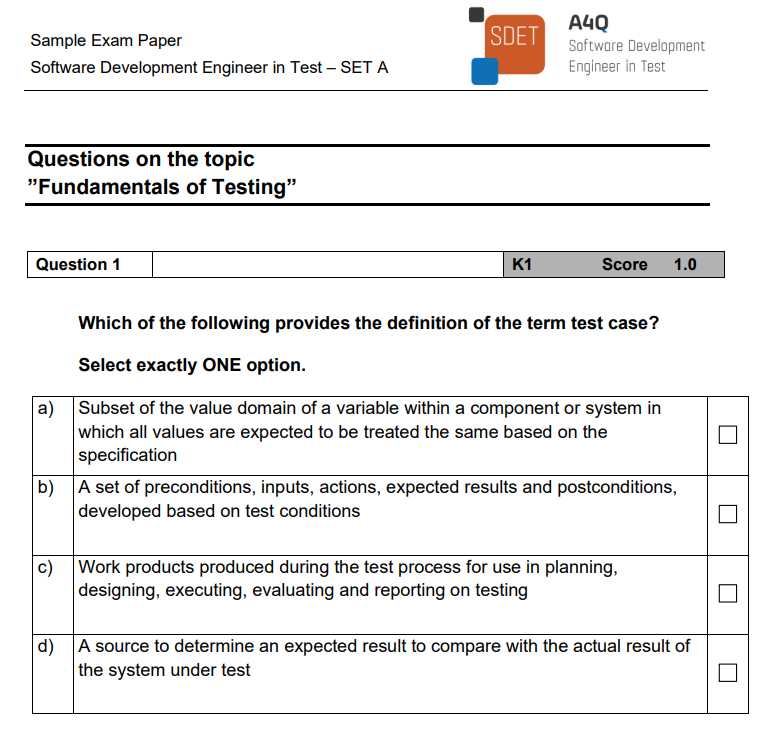
Sample A4Q SDET exam paper. Source: ISQI
You may find the exam syllabus and mock exam questions/answers in the Attachment section on the official website. There is a time extension option for non-native speakers that can be requested under the specific instructions. There aren’t any entry requirements for candidates eligible for A4Q SDET certification. Still, passing the pre-exam training is recommended.
ISTQB Certified Tester Foundation Level (CTFL)
Exam duration: 60 minutes (+15 additional minutes for non-native languages)
Exam questions: 40
Exam price: $250 USD Certified Tester Foundation Level (CTFL) is the certification that provides basic testing knowledge applicable for practical use. One of CTFL’s benefits is that it clearly explains the concepts and terminology used in the testing domain worldwide. This certification is designed for anyone who strives to demonstrate practical expertise in the fundamental concepts of software testing. Therefore, it’s applicable for such roles as SDETs, software developers, testers, test engineers, test analysts, user acceptance testers, test managers, and so on. Additionally, CTFL Foundation Level certification would be a good fit for those who need to gain basic knowledge of what software testing is as a process, software development managers, project managers, business analysts, etc.
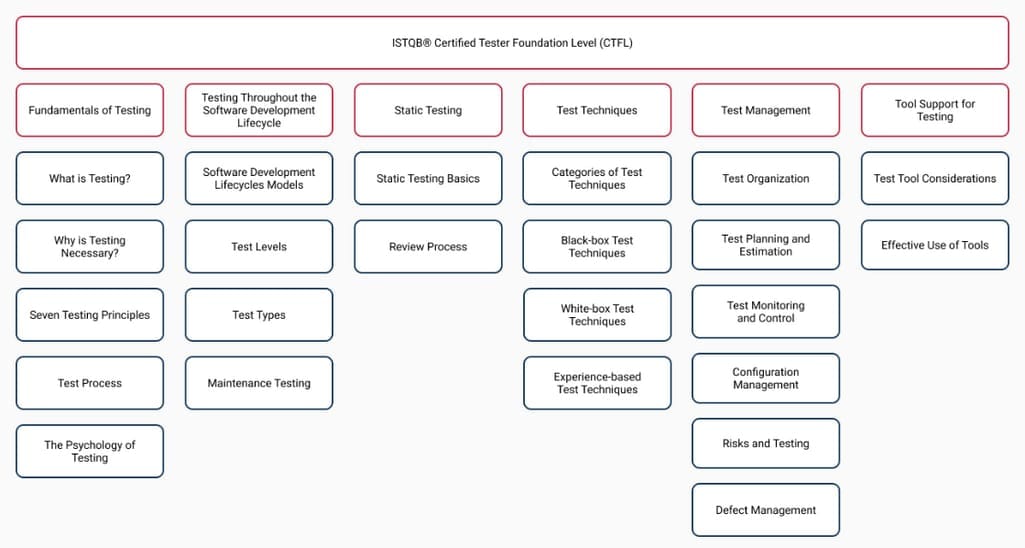
Contents of CTFL certification. Source: ISTQB
As a result, candidates that have achieved the Foundation Level CTFL certification should be able to demonstrate deep expertise in different development and testing practices and understand fundamental concepts of software testing. Holders of this certification become eligible for proceeding to the next stage of the Core stream and take Test Analyst or Technical Test Analyst level certifications.
ISTQB Agile Tester Certification (CTFL-AT)
Exam duration: 60 minutes (+ 15 additional minutes for non-native languages)
Exam questions: 40
Exam price: $150 USD
Certified Tester Foundation Level Agile Tester (CTFL-AT) is a certification offered by ISTQB that provides testing skills essential for successful contribution to an Agile project. It covers the principles of agile software development and is designed for professionals who intend to start implementing Agile methods in the future.
By the way, gaining this certification becomes possible only after a candidate has held CTFL, the one we've just mentioned and discussed above.
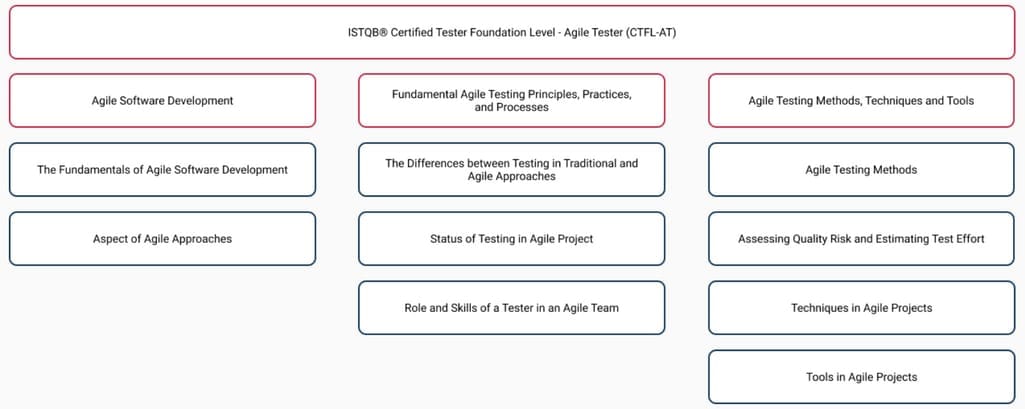
Contents of CTFL-AT certification. Source: ISTQB
Candidates who achieved CTFL-AT should be able to effectively collaborate in a cross-functional Agile team. They should be familiar with the basic practices and principles of Agile software development. Moreover, gaining this certification helps to assist business stakeholders for identifying testable and understandable user stories, scenarios, and requirements.
ISTQB Certified Test Automation Engineer (CT-TAE)
Exam duration: 90 minutes (+ 15 additional minutes for non-native languages)
Exam questions: 40
Exam price: $229 USD
The ISTQB Test Automation Engineer (CT-TAE) certification is designed for advanced-level specialists with a solid background in software testing who aim to further develop the level of their expertise in this field. The exam covers the processes, tools, methods, and concepts used to automate dynamic functional tests, as well as the way these tests are related to test management, the software development process, and quality assurance.
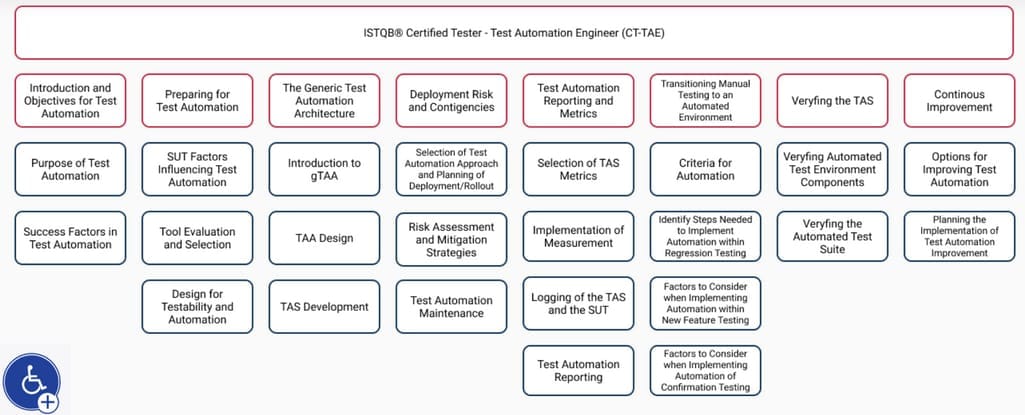
Contents of CT-TAE certification. Source: ISTQB
Candidates who achieved CT-TAE certification should be able to effectively accomplish multiple tasks, such as developing a plan of integrating automated testing, designing test automation solutions that would meet the business requirement of a particular project, etc.
SDET Training for Selenium WebDriver
Course duration: 15h 48m total length
Course price: 13.99$
SDET training is a complete SDET training course on Selenium WebDriver based on Java language, coding interview, API Testing & Automation Testing, etc. The course consists of 77 lectures with a total lendth of almost 16 hours. The training is designed for a wide range of candidates, starting from the students who want to learn the essentials of QA test automation, up to the functional testers who would like to switch their career to SDET or an automation engineer’s role.
The applicants for SDET training course need to possess basic knowledge of Java and Eclipse IDEm as well as have expertise at software automation testing.
When a company may need SDET
Your business requires performing a high volume of testing. When a tech organization has to perform a high volume of testing, manual testing becomes deeply impractical. SDET specialists can be useful here as this role can foster testing software products quickly and efficiently.
You need to reduce costs. Manual testing can be time-consuming and expensive, especially when dealing with testing a large software product or performing a high volume of tests. SDET specialists can design and develop automated testing scripts and perform source code reviews that can help companies reduce expenditure on human resources. Moreover, this specialist can think from the perspective of a developer, tester, and QA engineer.
There are issues inside the CI/CD processes. As we have previously mentioned, one of responsibilities of an SDET specialist is to develop continuous integration and continuous delivery/deployment pipelines. So if there are problems within CI/CD, the software development engineer in test is the one who can create optimized testing strategies to provide and maintain good test coverage.

